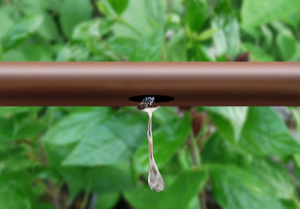In our wet climate we don’t realise how much water plants use until we get a glasshouse or tunnel, and have to provide all of it ourselves. What are the options?
Watering-cans are accurate and economical with water but very laborious to use for more than a few plants. Hosepipes deliver more water but can splash mud and disease spores all over your plants. Controlling the jet of water with the tip of your finger or thumb is an acquired skill.
Polytunnels often have overhead spray-lines. They are effective, but spray everything below them whether it needs water or not, and if not hung perfectly level the lowest parts drip for ages after the flow is turned off.
Seep-hose, laid around and between your plants and dripping water from its many holes, is efficient and effective but doesn’t work well with pots. Keep a watering-can for pots and trays and any additional spot-watering needed. If water charges are a problem, bury the seep-hose under the soil surface so less water is lost by evaporation. For convenience when you are away, add a battery-powered watering timer to water the plants every few days. It soon earns its cost in saved water and labour.
Water plants in the morning if you can. This gives more time for wet leaves to dry off before evening, reducing the danger of Botrytis mould and other fungus problems that thrive in damp conditions. A good soaking is better than little-and-often.
Soil temperature is more important than air temperature for plant growth. To avoid chilling pot-plants and seedlings with cold water, refill the watering-can when you finish watering: the water will be warmed up to ambient temperature by the time you need it.
Written for Polydome by Peter Whyte B Agr Sc (Hort), Nat Dip Sc (Apic), Dip Tr & Ed, MI Hort





